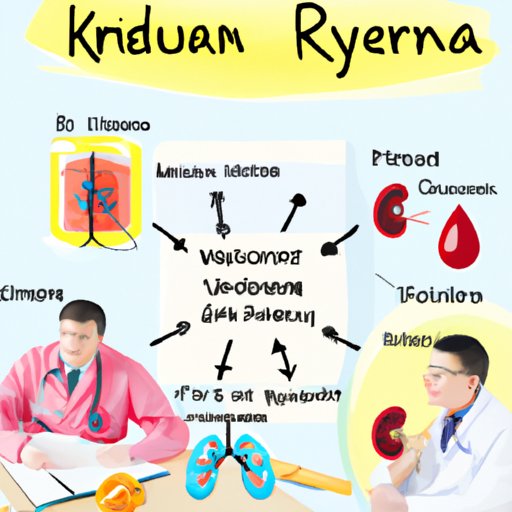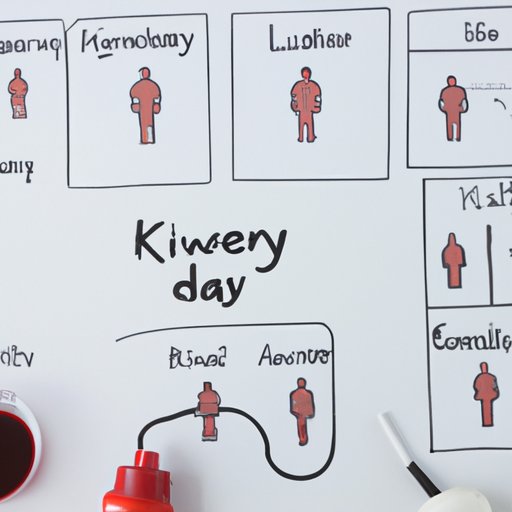Introduction
Kidney failure is a serious condition in which the kidneys are unable to filter waste and toxins from the body. When this happens, dialysis may be required to help maintain organ function and keep the patient alive. It’s important to understand the signs that you need dialysis and when it is necessary. This article will explore the early warning signs of kidney dysfunction, the different types of kidney disease, the symptoms of uremia, and the benefits of early dialysis treatment.
Identifying the Early Warning Signs of Kidney Failure and Need for Dialysis
The first step in understanding when dialysis is needed is to recognize the early warning signs of kidney failure or dysfunction. Common symptoms include fatigue, loss of appetite, nausea, vomiting, swelling of the face, hands, and feet, and dark urine. If any of these symptoms are present, it is important to see a doctor for further testing.
Tests used to diagnose kidney dysfunction include a blood test to measure creatinine levels, an ultrasound to look for blockages or other abnormalities, and a urine test to check for protein or other substances in the urine. If any of these tests show signs of kidney dysfunction, it is important to follow up with your doctor to determine the cause and whether dialysis is needed.

Diagnosing the Causes of Kidney Dysfunction and When Dialysis is Required
When diagnosing the cause of kidney dysfunction, doctors may use a variety of tests to identify the underlying cause. Different types of kidney disease can lead to the need for dialysis including acute kidney injury, chronic kidney disease, polycystic kidney disease, and glomerulonephritis. In some cases, dialysis may be necessary even if the underlying cause is not known.
It’s important to understand the role of dialysis and how it can help manage kidney failure. Dialysis helps to remove waste and toxins from the body and restore electrolyte balance. It can also help with fluid retention and reduce the risk of complications associated with kidney failure.

Understanding the Symptoms of Uremia and How it Can Lead to Dialysis
Uremia is a condition caused by the buildup of toxins in the blood due to kidney failure. Common symptoms of uremia include nausea, vomiting, confusion, fatigue, poor appetite, and shortness of breath. If left untreated, uremia can lead to severe complications such as coma and death. In cases of severe uremia, dialysis may be required to help manage the condition.
Uremia can also lead to anemia, which is a decrease in the number of red blood cells in the body. Anemia can cause fatigue, shortness of breath, and paleness of the skin. If anemia is present, it is important to seek medical attention as soon as possible.
Exploring the Different Types of Dialysis and What That Means for Patients
There are two main types of dialysis: hemodialysis and peritoneal dialysis. Hemodialysis involves using a machine to filter the blood and remove waste and toxins from the body. Peritoneal dialysis uses the lining of the abdominal cavity to filter the blood and remove waste and toxins from the body.
Both types of dialysis can help manage kidney failure and improve quality of life. However, it is important to discuss the risks and benefits of each type of dialysis with your doctor before making a decision.

Examining the Benefits of Early Dialysis Treatment for Patients with Chronic Kidney Disease
Early dialysis treatment can provide numerous benefits for patients with chronic kidney disease. It can help improve quality of life by reducing symptoms such as fatigue and nausea. It can also help reduce the risk of complications such as heart disease, stroke, and infections.
Early dialysis treatment can also help preserve kidney function and slow the progression of kidney disease. This can help prolong life expectancy and improve quality of life for patients with chronic kidney disease.
Conclusion
Recognizing the signs that you need dialysis is essential for managing chronic kidney disease. Common symptoms of kidney failure include fatigue, loss of appetite, nausea, vomiting, swelling, and dark urine. Tests used to diagnose kidney dysfunction include a blood test, an ultrasound, and a urine test. Different types of kidney disease can lead to the need for dialysis including acute kidney injury, chronic kidney disease, polycystic kidney disease, and glomerulonephritis. Uremia can also lead to dialysis if left untreated. There are two main types of dialysis: hemodialysis and peritoneal dialysis. Early dialysis treatment can provide numerous benefits for patients with chronic kidney disease. It can help improve quality of life and reduce the risk of complications.
If you have any of the warning signs of kidney failure, it is important to see a doctor for further testing. Early detection and treatment can help slow the progression of kidney disease and preserve kidney function. It is important to discuss the risks and benefits of dialysis with your doctor before making a decision.
(Note: Is this article not meeting your expectations? Do you have knowledge or insights to share? Unlock new opportunities and expand your reach by joining our authors team. Click Registration to join us and share your expertise with our readers.)
